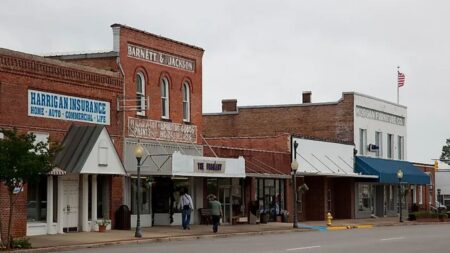Alabama is a state with a rich history, culture, and natural beauty. However, not all of its towns are thriving or appealing to residents and visitors alike. Some towns face serious challenges such as high crime rates, low incomes, poor education, and lack of opportunities. These factors have led many people to flee these towns as soon as possible, seeking better lives elsewhere. Here are seven of the most notorious towns in Alabama that people are leaving behind.
1. Selma
Selma is a town that played a pivotal role in the civil rights movement of the 1960s, as the site of the famous Bloody Sunday march and the Selma to Montgomery marches. However, despite its historical significance, Selma has not prospered in the modern era. It has one of the highest poverty rates in the nation, at 41.9%, and one of the lowest median household incomes, at $23,283. It also has a high violent crime rate, at 1,450 per 100,000 residents, and a low graduation rate, at 79.1%. Many people have left Selma in search of better opportunities, resulting in a population decline of 12.9% from 2010 to 2019.
2. Anniston
Anniston is a town that was once a thriving industrial center, producing iron, steel, and munitions. However, it has suffered from deindustrialization, environmental contamination, and economic decline. It has a poverty rate of 31.7%, a median household income of $30,085, and a violent crime rate of 1,381 per 100,000 residents. It also has a low quality of life index, ranking 228th out of 228 cities in Alabama. Many people have left Anniston recently, resulting in a population decline of 8.5% from 2010 to 2019.
3. Bessemer
Bessemer is a town that was once a booming mining and manufacturing hub, earning the nickname “The Marvel City”. However, it has faced severe challenges such as racial segregation, urban decay, and unemployment. It has a poverty rate of 29.9%, a median household income of $31,308, and a violent crime rate of 2,986 per 100,000 residents. It also has a low educational attainment level, with only 13.9% of adults having a bachelor’s degree or higher. Many people have left Bessemer in the past decade, resulting in a population decline of 5.6% from 2010 to 2019.
4. Prichard
Prichard is a town that was once a prosperous suburb of Mobile, attracting middle-class families and businesses. However, it has experienced a downward spiral of fiscal mismanagement, corruption, and bankruptcy. It has a poverty rate of 33.9%, a median household income of $24,883, and a violent crime rate of 1,026 per 100,000 residents. It also has a low livability score, ranking 222nd out of 228 cities in Alabama. Many people have left Prichard in the last decade, resulting in a population decline of 9.8% from 2010 to 2019.
5. Fairfield
Fairfield is a town that was once a thriving community, home to the headquarters of U.S. Steel and the alma mater of baseball legend Willie Mays. However, it has suffered from the decline of the steel industry, the loss of major employers, and the deterioration of infrastructure and services. It has a poverty rate of 35.8%, a median household income of $28,590, and a violent crime rate of 2,014 per 100,000 residents. It also has a low graduation rate, at 77.4%. Many people have left Fairfield recently, resulting in a population decline of 11.5% from 2010 to 2019.
6. Lanett
Lanett is a town that was once a prosperous textile manufacturing center, located on the border of Alabama and Georgia. However, it has been hit hard by the closure of mills, the loss of jobs, and the influx of drugs and crime. It has a poverty rate of 30.4%, a median household income of $26,938, and a violent crime rate of 1,274 per 100,000 residents. It also has a low quality of life index, ranking 226th out of 228 cities in Alabama. Many people have left Lanett in the past decade, resulting in a population decline of 7.9% from 2010 to 2019.
7. Tarrant
Tarrant is a town that was once a vibrant industrial and residential area, located near Birmingham. However, it has faced multiple challenges such as poverty, pollution, and blight. It has a poverty rate of 28.6%, a median household income of $31,250, and a violent crime rate of 1,647 per 100,000 residents. It also has a low educational attainment level, with only 11.4% of adults having a bachelor’s degree or higher. Many people have left Tarrant in recent years, resulting in a population decline of 10.4% from 2010 to 2019.
Conclusion
These are some of the towns in Alabama that people are fleeing as soon as possible, due to various reasons such as crime, poverty, education, and opportunity. While these towns have some positive aspects and potential for improvement, they also face many challenges and difficulties that make them unattractive and undesirable for many residents and visitors. Therefore, many people are choosing to leave these towns behind and seek better lives elsewhere.


